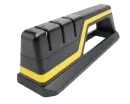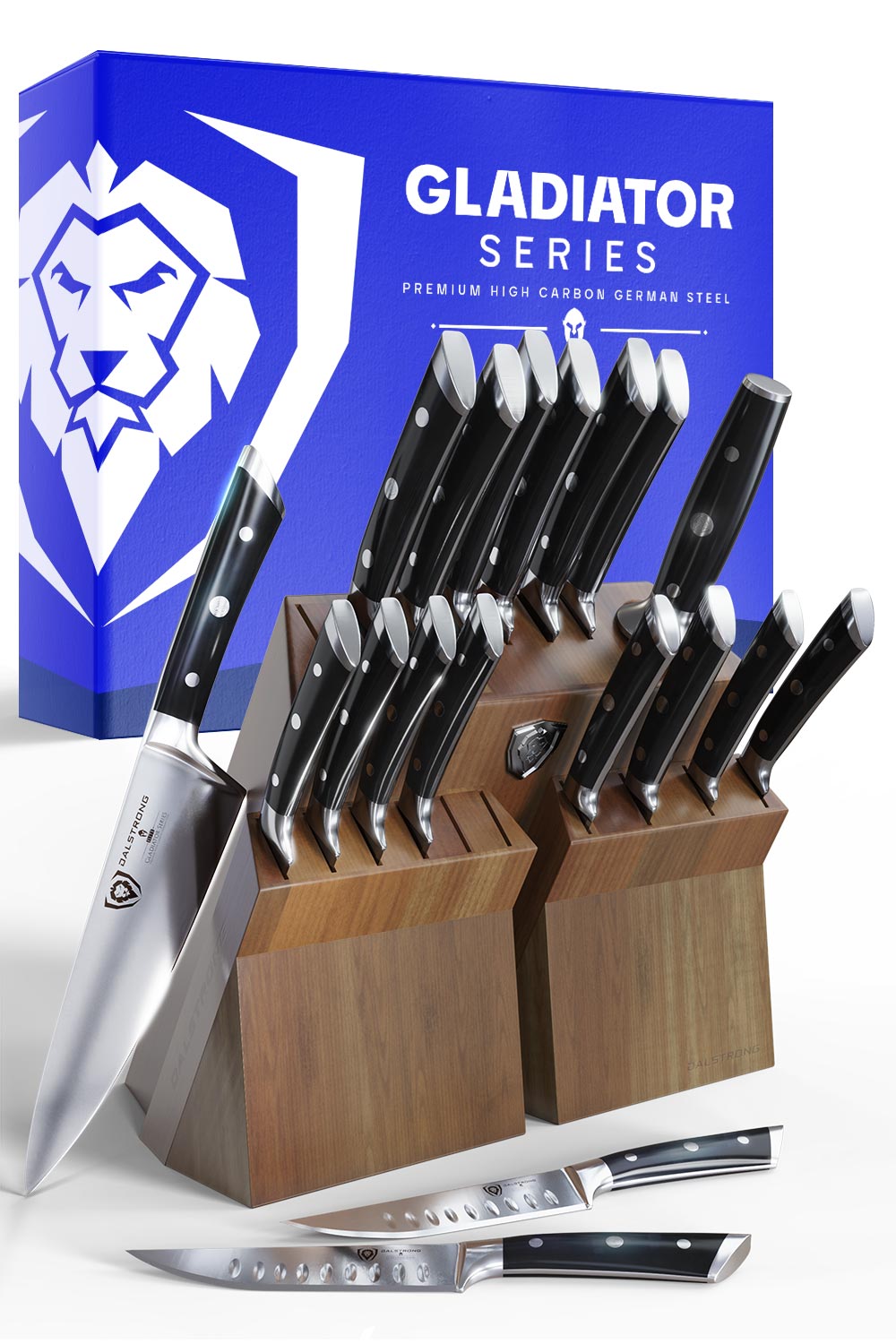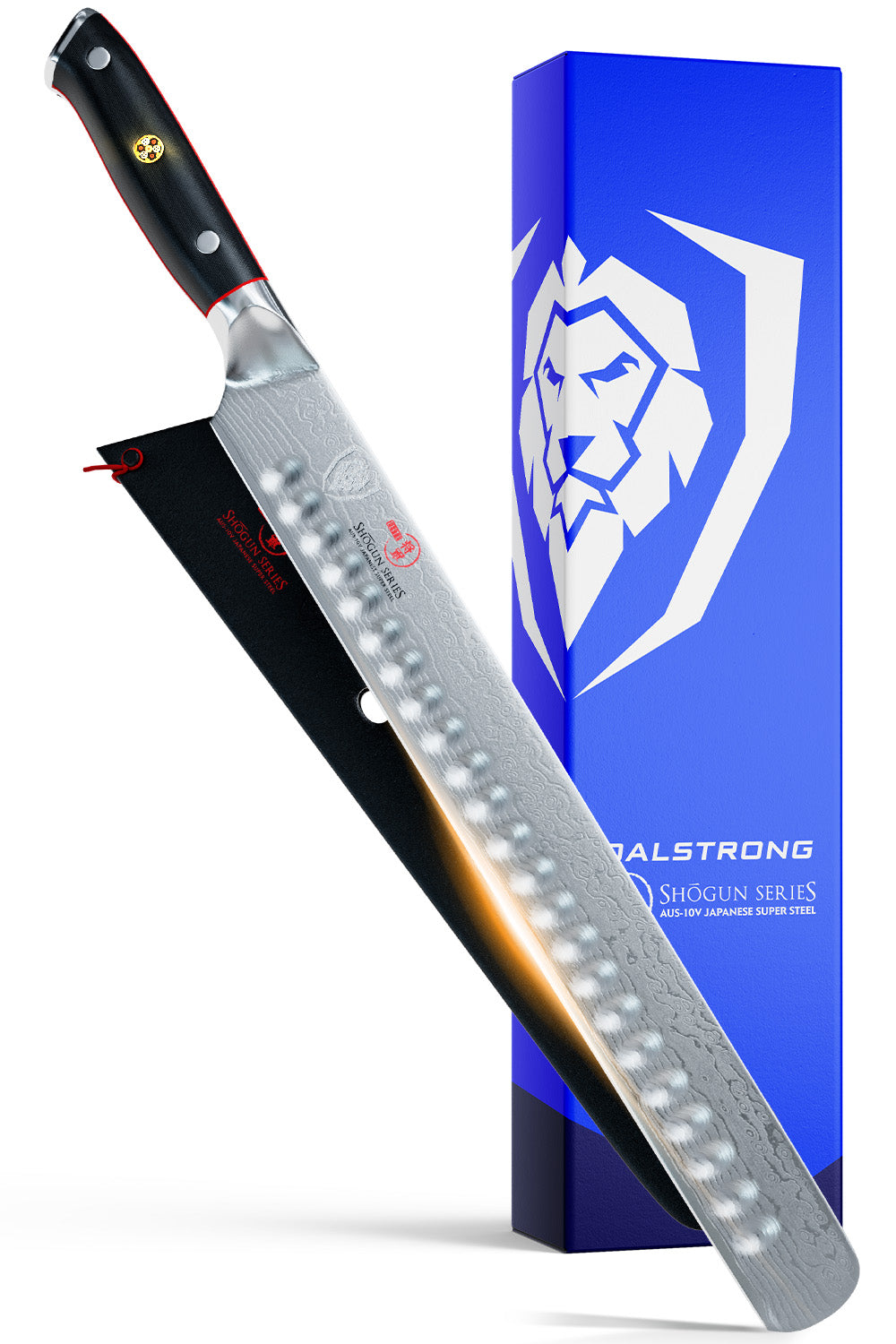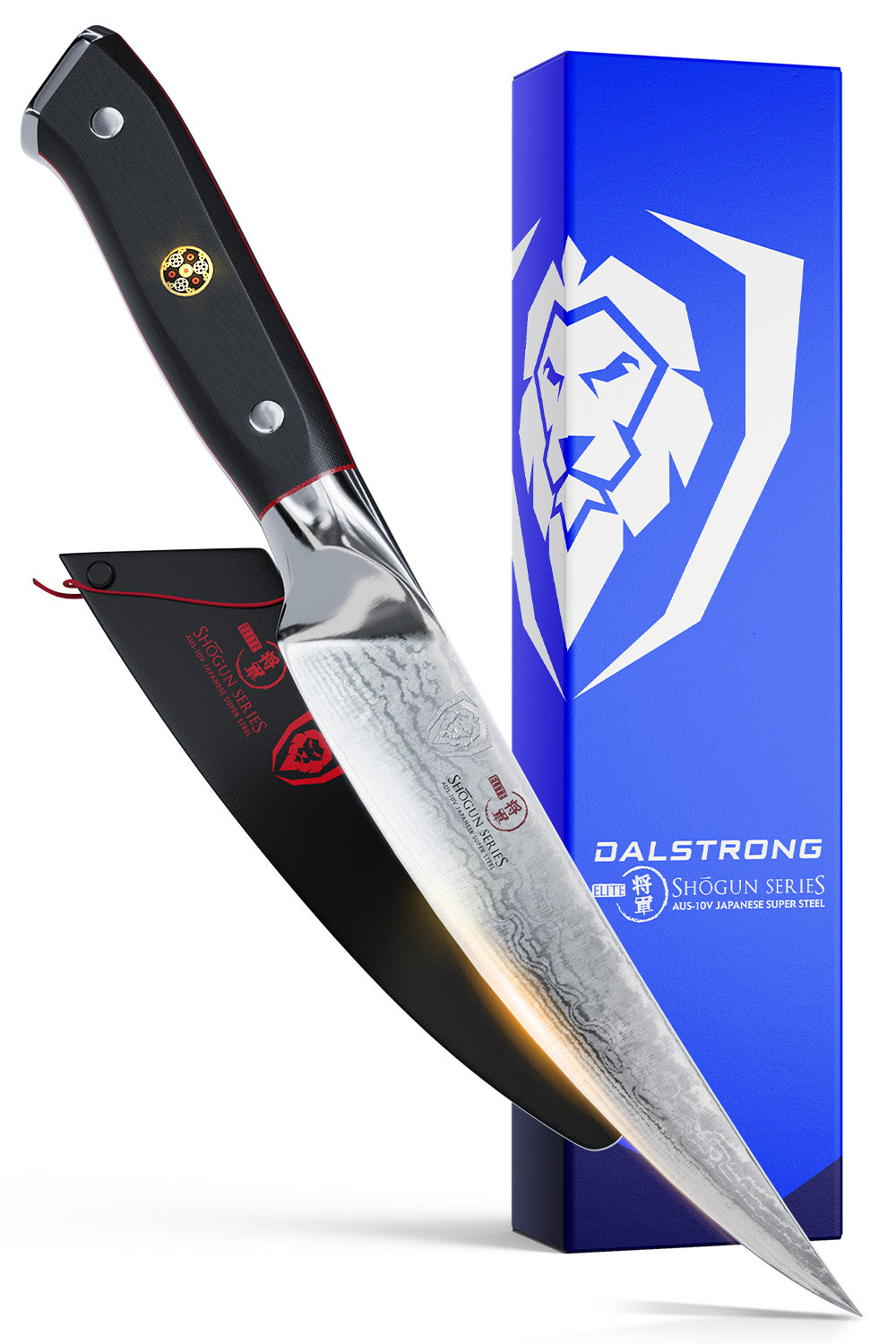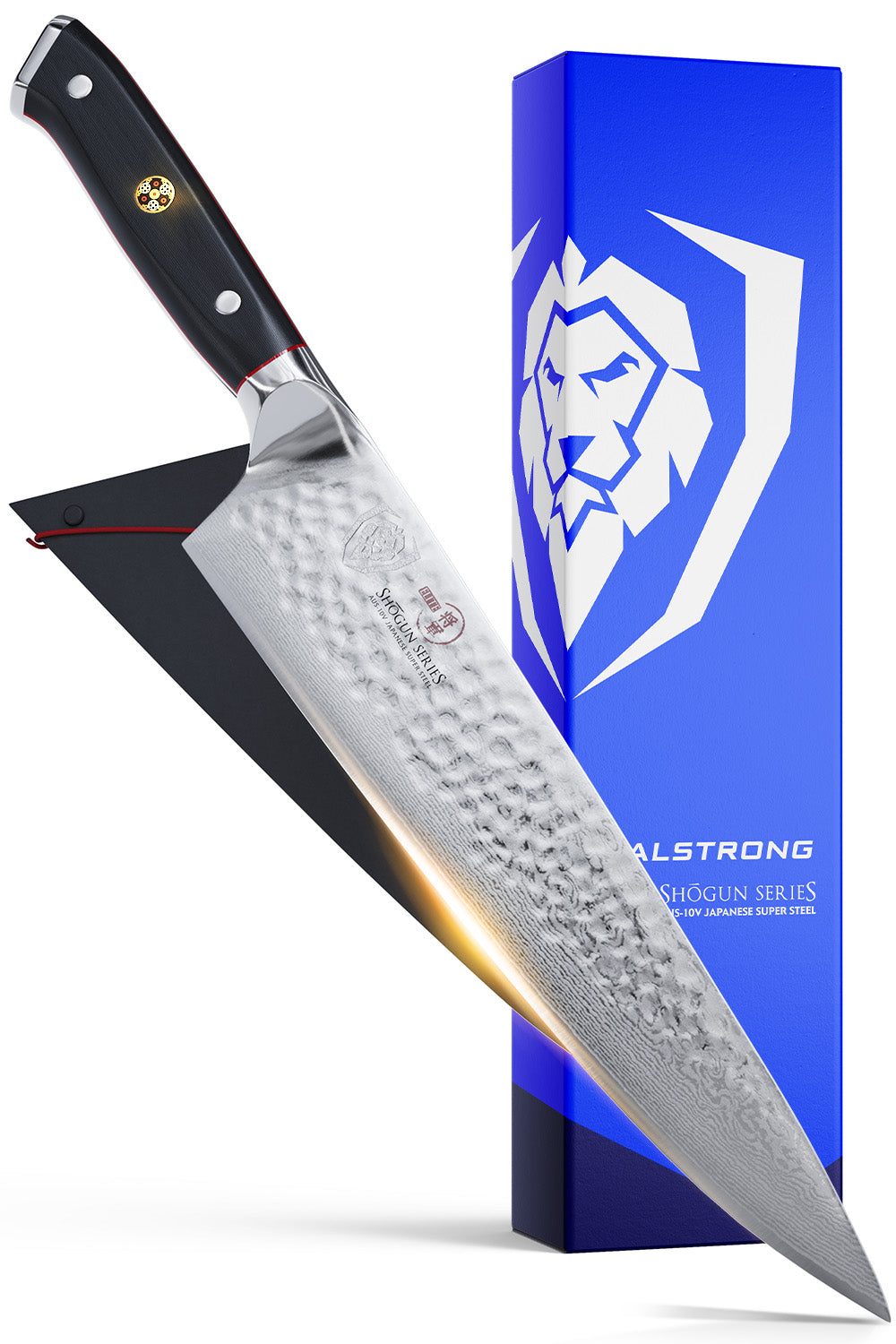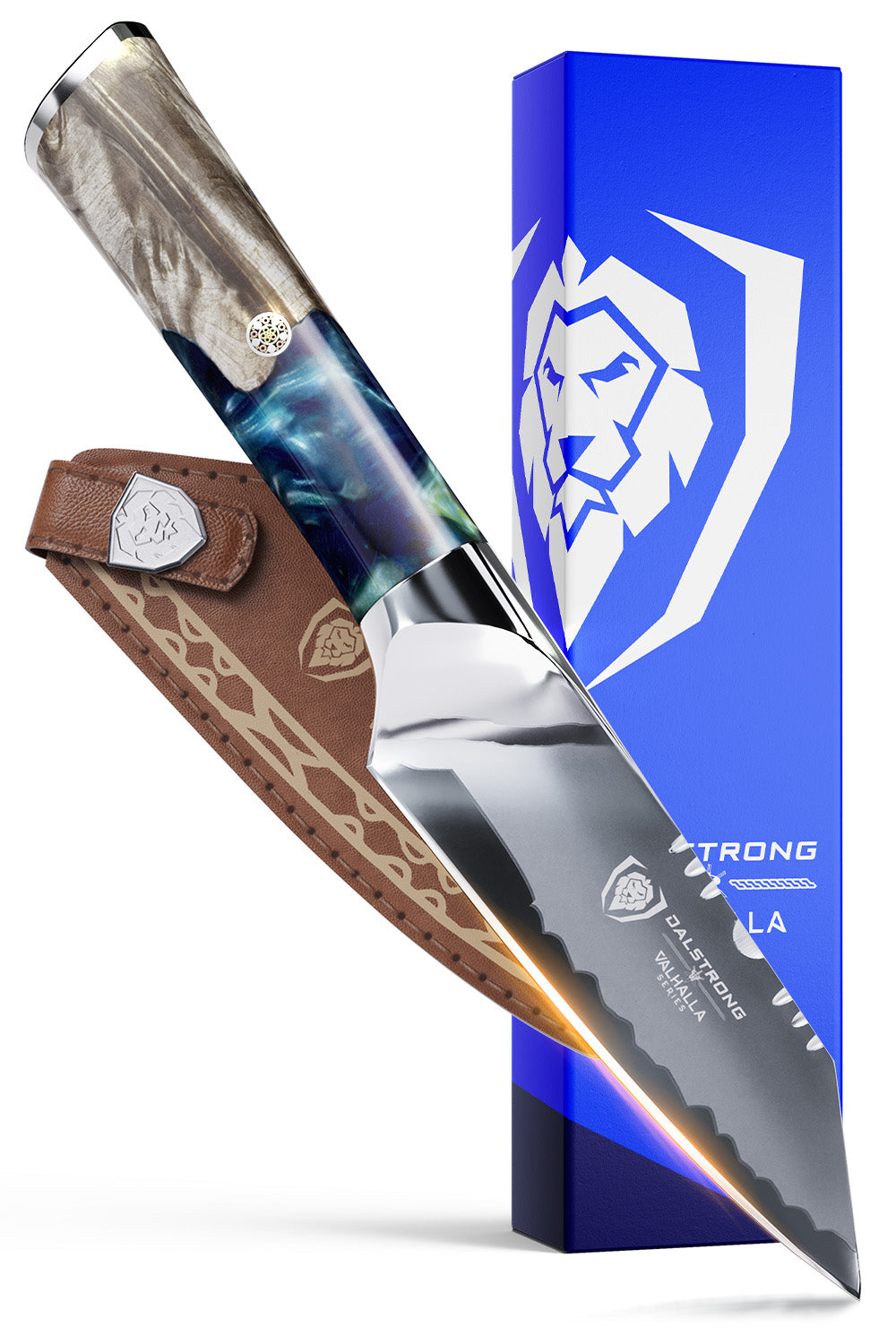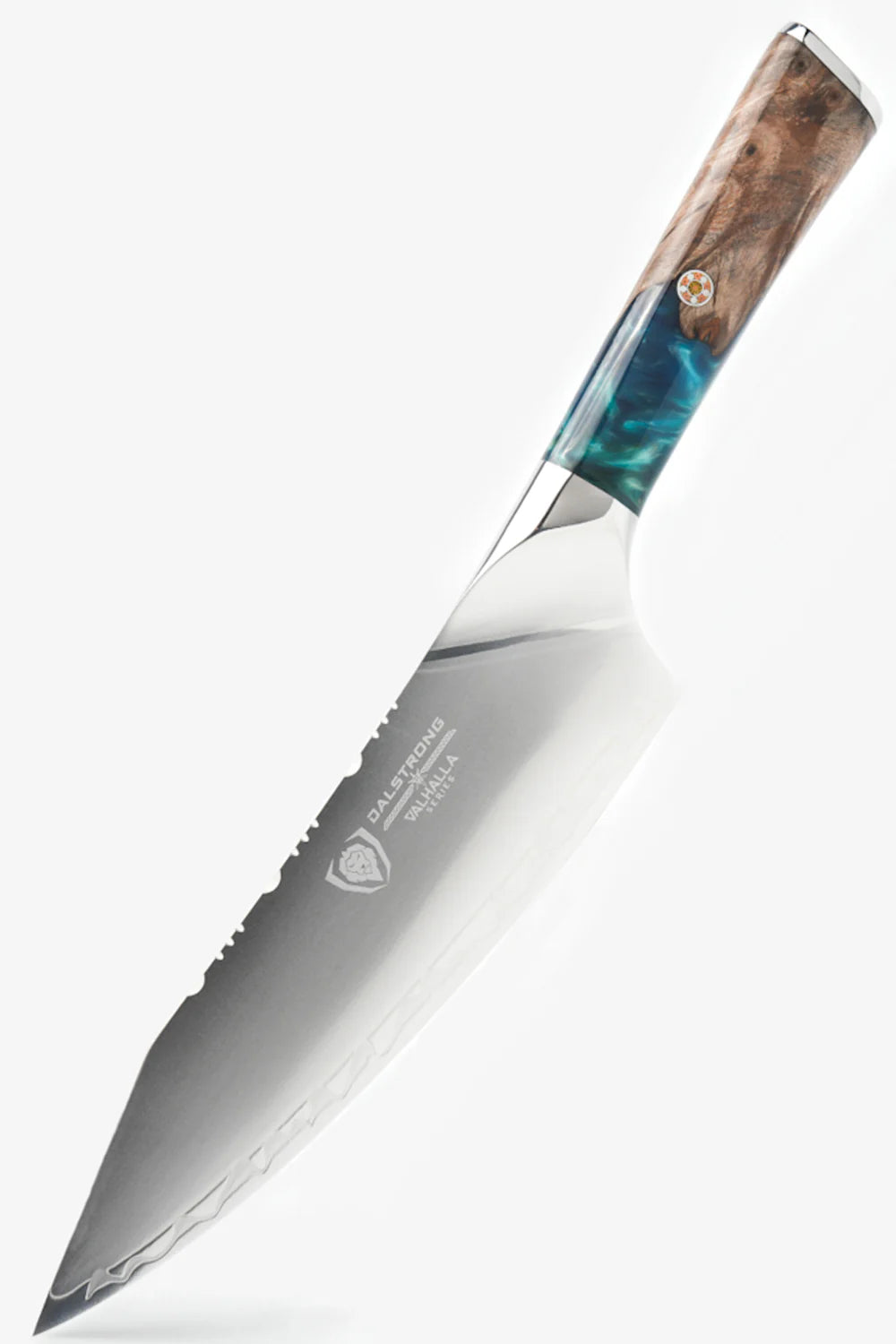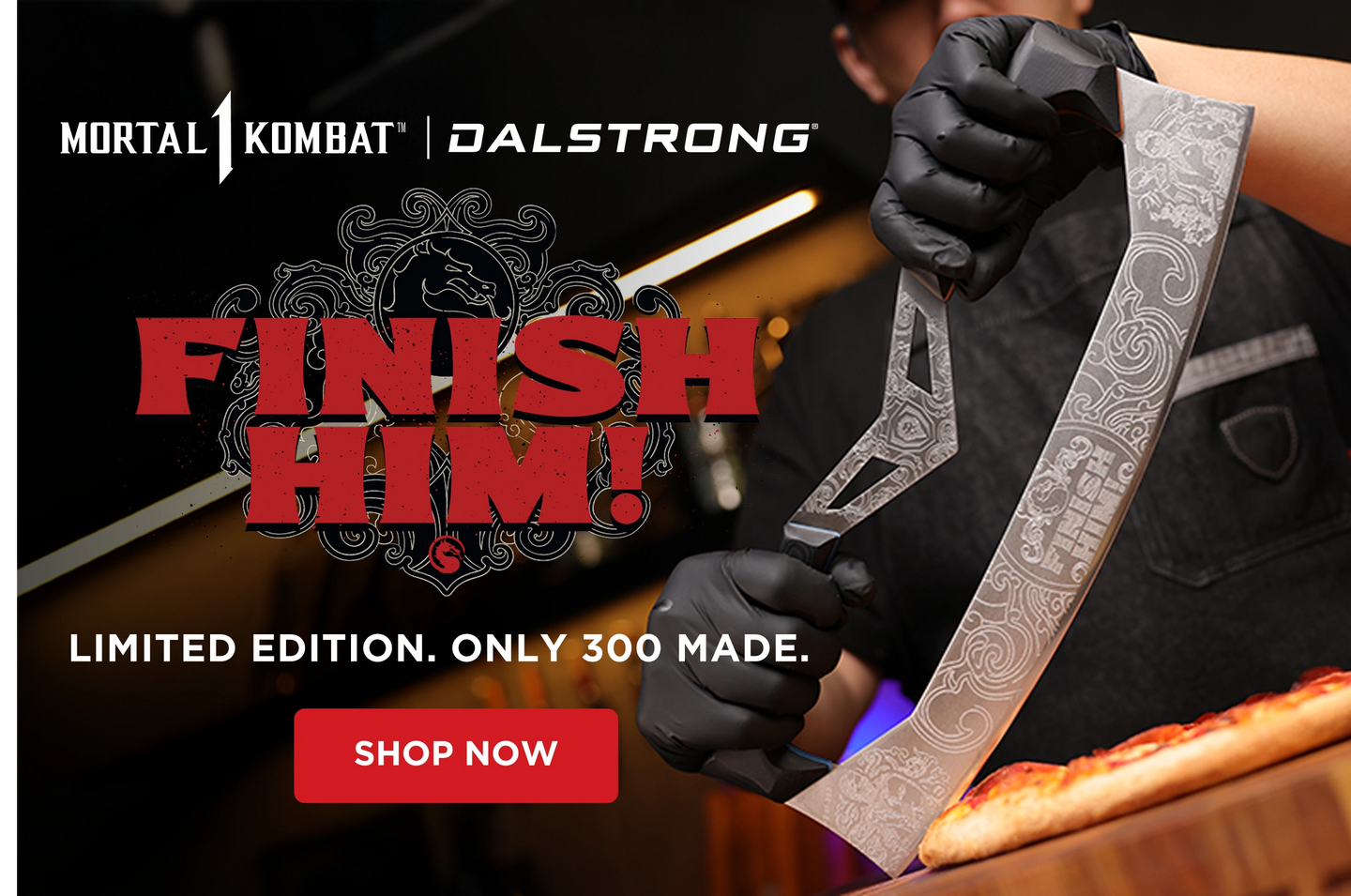
Damascus Knife: The Complete Guide
With its historical reputation as the metal used for the best swords over hundreds of years and its distinctive wavy design, Damascus steel is a beauty to behold. Sharp, strong and reliable is the reputation built for these knives and can be recognized by the wavy, beautiful pattern found on the surface of the steel blade.
Continue reading this article to know more details about this solid steel and find answers to the most commonly asked questions about kitchen knives made from Damascus steel.
1. What Is A Damascus Knife?

Damascus steel is an easily recognizable type of steel that gets a distinct look from its wavy patterned design. While this steel is known for its sleek look and beautiful aesthetics, Damascus steel is highly valued because it is hard and flexible while maintaining a sharp edge.
Damascus steel, as a blade material, originated in the European and Asian sword smithery. Early on they realized that forging and folding at least two different types of steel results in a better, more durable steel quality. The distinct pattern on the steel blade knife also gives this steel a special look, making it stand apart.
These knives have always fascinated people and continue to do so to this day thanks to their quality and functionality for a variety of tasks.
This sturdy steel is made with a wavy surface pattern that is produced by hammer-wielding the strips of steel and iron followed by repeated forging and heating. Back in the day, this steel was used chiefly for knives and sword blades but today pocket knives, butterfly knives, fixed blade knives, and swords are made in Damascus steel.
Although Damascus knives date back to ancient civilizations, today the method has been modified a bit. Modern Damascus knives are either forged-welded with different types of steel or with one kind of steel that’s folded and refolded.
Both these methods create a unique pattern that’s unlike any other knife blade. You can also find a Damascus knife in just about every style and for any purpose. From hunting to chef’s knives for your kitchen, Damascus steel can be used in so many different ways.
2. How Damascus Steel Got Its Name

The origin of the name “Damascus Steel” is somewhat of a legend. Some say that two Islamic scholars, Al-Kindi and Al-Biruni (from circa 800-873 CE) wrote about swords and steels based on the appearance, geographical location of where they were produced or forged, and the name of the blacksmith that crafted it. In both their writings the word ‘damascene’ or ‘Damascus’ were used when describing the swords to some extent.
But these aren’t the only stories that revolve around the origin of Damascus knives.
Over a thousand years ago, the local blacksmiths in the city of Damascus were regarded as the finest in the world owing to their unique techniques of steel fabrication. According to them, this method produced the most beautiful and strong swords in the world.
Their unique process involved heating and folding the steel many times, over and over again, to make the blade stronger and more ductile. As a result of this beating and hammering technique, a unique look was produced. The blade knives had an intricate swirl pattern that looked like waves crashing over a beach.
Not only were these blade knives exceptionally appealing to look at, but their performance was said to be truly spectacular. It was also rumored that these ‘Damascus’ swords were able to hold a keen edge for an unreasonably long time and were much less prone to chipping and damage.
While the reports of steel quality over 900AD are spotty, it is believed that most steel products produced then were more durable than hard plastic. Plate armor wasn’t a viable option until nearly the 14th century, so at that time, Damascus steel must have been viewed as an incredible innovation.
The most common and sensible explanation, however, is that the steel is named after the capital of Syria, Damascus, the largest of the cities in the ancient Levant. It has never been confirmed but it can either refer to swords made or sold in Damascus directly or it may just refer to the aspect of the pattern on the blade, by comparison with Damask fabrics which were also named for Damascus.
3. How Damascus Knives Are Made

Over the years, the original Damascus Steel making process has seen a lot of changes. Modern Damascus steel is made by either forge-welding different types of steel together before beating, twisting, and manipulating the metal or by flattening out and then folding a single type of steel to produce layers in the metal. Both these techniques result in the organic pattern that is typical of Damascus knives.
Even though the techniques used today are primarily for aesthetic reasons, the folding and refolding process does have the benefit of evening out any impurities in the metal. More advanced techniques like acid etching can also be used to emphasize the unique pattern created by the process.
If you go to compare, you’ll find that ancient Damascus steel is entirely different from modern Damascus steel. The exact knowledge and technique used to produce this kind of steel are now lost in history.
Ancient Damascus steel was most popularly known for its strength and durability. It was produced in areas of the Near East using a type of steel originally found in India, called Wootz steel. This kind of steel is characterized by levels of carbon compounds known as ‘carbides’, which run through the steel. On analyzing ancient Damascus steel blades, we see that certain impurities added during the production process added strength to the metal and made it more flexible and durable.
4. What To Look For When Shopping For A Damascus Knife

Among the wide range of gourmet specialist blades available, the only one loved by culinary experts is a knife made with strong and durable Damascus steel.
Here’s a list of some things to keep in mind when shopping for a Damascus knife for your kitchen:
Sturdiness
Damascus steel knives are most popularly known for their extraordinary hardness. More hardness implied less effort on the blade’s edge, making it last for a longer time.
Execution
In the blade world, execution boils down to how well and to what extent can the steel blade ideally cut nourishment. That means that a blade’s only as good as its hardness. Hard metal knives, made with Damascus steel, hold their unique edge far longer than milder metal knives. Damascus steel cutting edges normally sport a smaller edge, making it cut through meat more effectively.
Financial Limit
Overall, Damascus knives are more costly than ordinary kitchen knives. So when you look for a Damascus steel knife be ready to spend a little extra from your pocket, but be rest assured that these knives are a great investment for any chef, home, or professional.
5. How To Care For Damascus Steel

A Damascus steel knife that has been carefully crafted over hundreds of hours deserves the utmost attention and care. A legacy masterpiece requires safeguarding for maximum longevity. Damascus steel requires special care for it to retain its original luster and beauty.
You must keep in mind that many hand-forged Damascus blades are made out of high carbon steel with amounts of chromium in the alloy. With such steel, the blade can easily rust if not looked after properly. Collectors should ensure to keep their blades clean and avoid rust or staining.
After cleaning a Damascus steel knife, you should lubricate the blade with a specialty wax to protect it from moisture. Keeping the blade away from rust ensures that the steel’s pattern remains as striking and vivid as the day it was hand-forged.
Other elements such as textiles and chemicals can also affect the blade’s look. Using a rough cloth or metal cleaner can remove the etched oxidation that makes the blade’s pattern visible.
Being mindful of the storage conditions is also very crucial to a blade’s longevity. When it’s not being used, make sure to store your Damascus steel knife in a dry interior environment, free from fluctuating moisture levels and temperature. A box or a soft case is a must to store these knives.
6. How To Spot A Fake Damascus Knife
Now that we know the details about what a Damascus knife is and how it is made, it is easier to identify a real Damascus steel knife from a fake one.
Let’s take a quick look at some of the ways you can spot this:
Look at the pattern.
This is the fastest way to spot a fake Damascus knife. Because of how these knives are forged and produced there is no way to produce two knives with completely identical patterns. So if all kitchen knives in a set have the same pattern, with the same features, they are not made from real Damascus steel.
If you’re buying an individual knife, you can still spot a fake by looking at the pattern. It’s weird shaped, looks manufactured, or looks unnatural, even like someone has drawn the pattern, then it is fake.
With time you will develop a feel for this. Fake Damascus steel usually has a high contrast between light and dark spots, and the lines between them are usually very sharp and clean, not blurred like they are in real Damascus steel.
Check for change in geometry.
Earlier, we spoke about how a true Damascus pattern is present throughout the piece, not just on the surface. So, if we see a Damascus pattern on the spine of a knife, on the handle, or in hard-to-reach places, and this pattern is consistent through the knife, this is most likely true Damascus steel.
But if these surfaces do not have a Damascus pattern, it might indeed be a case of Damascus pattern imitation. The reason behind the lack of Damascus pattern could also be that these surfaces were not etched at all or polished to a mirror-like finish or they were etched and subsequently polished, but not fine enough – sanding or not fine enough polishing removes the Damascus pattern.
Knife manufacturers use more exotic materials to produce knives. They also combine Damascus steel with other materials to produce tough knives. Such knives can have a very hardcore and consequently a cutting edge, while at the same time having a super tough material around the core. That means that the knife will remain sharp for a long time.
Now you ask, so what does this have to do with determining whether a knife is made from real Damascus steel or merely an imitation? Given that these knives are made from mixed materials, the knife may lack the Damascus pattern. The pattern is only visible when the thickness increases. This way we can see where the core ends and Damascus steel begins.
7. Differences Between Damascus Knives vs. Carbon Steel Knives

|
Damascus Steel |
Carbon Steel |
|
|
Composition |
Damascus steel is the name given to steel which is made by forging together iron and steel or steel alloys. |
Carbon is a hard element and so blades made from carbon are naturally hard, which means they offer greater edge retention and are good at resisting abrasion and retaining shape. |
|
Texture |
Damascus knives have flowing patterns on the surface, created by the process of folding the metals together. These patterns vary from one blade to the next and can resemble waves or swirls. |
Carbon steel knives have a more modern, simplistic, and practical look. |
|
Appearance |
The history and traditional appearance of Damascus knives make them very attractive to chefs and collectors. |
Carbon steel knives are not as elegant as Damascus steel knives, which may turn off some collectors and chefs who are looking for a knife they can display and show off. |
|
Price |
Knives made with Damascus steel carry a higher price tag |
Knives made with Carbon steel are more affordable. |
8. Differences Between Damascus Steel Knives vs. Stainless Steel Knives

|
Damascus Steel |
Stainless Steel |
|
|
Composition |
Different types of stainless steel are forged together to produce Damascus steel. |
Stainless steel is a combination, or alloy, of iron and a small amount of carbon. It is stronger than just plain iron, but still prone to rust and corrosion. To make it corrosion-resistant, it is combined with at least 10-30% of chromium. |
|
Appearance |
Damascus steel has swirl, wavy patterns. These were originally due to impurities such as tungsten in the blocks of wootz steel that the steel was smelted from. |
Stainless steel has a plain shiny surface. |
|
Uses |
Damascus steel is used exclusively to make knives. |
Stainless steel can be used to make other things in addition to knives. |
|
Resistant To Corrosion |
Both Damascus steel and Stainless steel is resistant to corrosion. |
|
|
Durability |
The amalgamation of different elements in both types of steel provides them with maximum durability, edge retention, and flexibility. |
|
9. Damascus Knife Recommendations
Other than reliable and durable cookware, an apron, and a sturdy cutting board, every kitchen needs a strong and sharp Damascus steel knife.
Looking to invest in a Damascus knife for your kitchen? While there are tons of options out there, some stand out more than others. These knives are made with a special technique that results in a unique and one-of-its-kind wavy, mottled pattern running across the blade knife.
You can find a Damascus steel knife in just about every style and for any purpose, which can make picking the right one slightly confusing. So if you’re wondering which Damascus option is the right fit for you, check out our picks for the best Damascus steel knives and find the perfect fit for your kitchen needs.
Chef’s Knife
1. Chef's Knife 8"| Shogun Series X | Dalstrong
The 55mm wide blade of this knife is precision-forged from a single piece of 66-layered Damascus high-carbon stainless steel cladding. The blade provides the knife with incredible strength, enhanced flexibility, and hardness.
The exquisite finish on the knife is not only a beautiful statement in craftsmanship, but it also helps reduce drag and minimize stuck-on food.
Pros:
- 66-layered Damascus used in this knife is sharpened using the ancient 3-step Honbazuke method.
- The knife sails through culinary challenges with its scalpel-like sharpness.
- It comes with a tapered bolster that provides perfect balance, finger protection and ensures a comfortable grip.
- The Damascus steel used in this knife makes it rust and corrosion resistant.
-
This knife is built to last a lifetime and is very easy to maintain as it cleans easily.
Cons:
- The cost of this knife can seem pretty steep for some people.
- The 55mm blade can be pretty intimidating in size, especially if you’re not experienced in using and handling professional-grade knives.
Utility Knife
2. Utility Knife 6" | Shogun Series | Dalstrong
The jack of all trades, this knife is a professional, high-performance solution for all your kitchen tasks. The blade of this knife works like a wonder where more precise cuts are needed, like trimming broccoli, green beans, and other smaller vegetables.
The slight curve on the betty of this knife also allows for moderate rocking cuts, making chopping, slicing, and dicing tasks a breeze. The carefully engineered knife is also incredibly strong with life-long durability, making it a great addition to your kitchen knife arsenal.
Pros:
- This Utility knife is made with 67-layered Damascus steel and is rust and corrosion resistant.
- The knife is designed to provide superior hand control and a comfortable grip.
- The precise tempering of the blade knife provides enhanced strength, flexibility, and hardness to the knife.
Cons:
- This knife might be too big to perform more delicate tasks like deveining shrimp.
- Pricing is a little higher than other utility knives and may not be affordable to all.
Meat Knife
3. BBQ Pitmaster & Meat Knife 8" with Forked Tip & Bottle Opener
Love a good BBQ session? Meet your new best friend! The pitmaster knife is a thoughtfully designed knife crafted for the loyal members of the BBQ community.
The razor-sharp blade of this knife is meticulously hand-crafted and works perfectly for slicing, butchering, and serving any kind of meat, be it a brisket, set of ribs, roasts, poultry, or fish.
This versatile masterpiece features a unique fork-end, ideal for flipping meat directly on the grill and for transferring foods from the grill to the plate.
Pros:
- This knife is made with 67-layered Damascus steel, making it strong and providing flexibility to the blade knife.
- This one-of-its-kind knife is perfect if you are some who BBQs frequently.
- Serves a cold beverage while grilling conveniently, with the added bottle opener on the spine of the blade.
- This knife particularly stands out for its striking features and style.
Cons:
- Investing in this knife only makes sense if you’re big on barbecuing as it is designed particularly for that function.
- The knife comes with a higher price tag which might not be affordable for all.
Paring Knife
4. Serrated Paring Knife 3.5" | Shogun Series | Dalstrong
This highly versatile knife features razor-sharp serrations perfectly spaced along a small, narrow blade that tapers to a point. It is ideally used to cut and peel tough-skinned fruits like oranges, lemons, limes, kiwis, and avocados. This knife also provides great control when dealing with vegetables with soft interiors, small crusty loaves, pastries, and dried or tough meats.
The short and precise blade of this knife is also suited for detailed cutting and making patterns and designs on the surfaces of food.
Pros:
- The knife is crafted using 67-layered Damascus steel and comes with scalpel-like sharpness.
- The full tang of the knife provides it with maximum robustness and grip.
- The knife provides incredible edge retention, making it easy to maintain and last for longer.
- The tapered blade of the knife provides minimal slicing resistance and makes it easy to maneuver.
Cons:
- If you are looking for a knife that would help you handle bigger culinary tasks like cutting tougher meats, this might not be the ideal knife for you.
- Customers may prefer a straight edge knife rather than a serrated paring knife.
Cleaver Knife
5. Meat Cleaver 9" Raptor | Shogun Series | Dalstrong
A powerhouse tool for ruthless chopping efficiency, this cleaver is a chef and butcher’s best friend. This knife is crafted to break down large cuts of meat like poultry, ribs, salmon heads, thick and tough-skinned fruits, and vegetables. The pointed tip of the cleaver helps you achieve perfect, precise, and juicy slices of meat.
Additionally, the blade length on this clever is longer than that of your typical boning knife. This works well because it acts as an extension of your arm, performing long, single slices of larger cuts of meat.
The tapered blade also minimizes surface resistance and curves inward to maneuver close to the bone handles, making sure that the process of separating the bone and the meat is ultra-efficient, while the fine tip gets in between joints with accuracy.
Pros:
- If you are a chef or cook who has to prepare large amounts of meat, this knife is built for you.
- 67 layers of premium high-carbon stainless steel give this knife exceptional strength, durability, and stain resistance.
- The longer blade length allows for longer slicing action, reducing wrist and hand fatigue.
Cons:
- This is a rather large knife to handle and can be intimidating for some.
- Since this cleaver is priced at a higher rate, it only makes sense to invest in one if you are someone who has to work with large amounts of meat.
All in all, Damascus steel is strong, durable, and makes good material for knives. I hope this read helped you gain some insights on Damascus steel and the knives that it produces.
So if you’re looking for a knife that would turn heads and be the star of the kitchen, you can opt for a Damascus steel knife that will perform well for a long time to come.
10. Frequently Asked Questions About Damascus Knives
What is special about Damascus knives?
Damascus steel is an easily recognizable type of steel that gets a distinct look from its wavy patterned design. While this steel is known for its sleek look and beautiful aesthetics, Damascus steel is highly valued because it is hard and flexible while maintaining a sharp edge.
What is a Damascus knife worth?
You'll find quite a few pocket knives, survival knives, hunting knives, and chef's knives within the price range of $30 to $200.
Is Damascus Good for knives?
Yes, A well-made Damascus blade will retain its sharpness for longer than most production quality blades.
Shop Dalstrong Shogun Series Knives Today
Written by Himani Vaid
Toronto-based food nerd turned food storyteller, Himani is a connoisseur of all things delish. Currently, busy thinking about what to eat next.

































